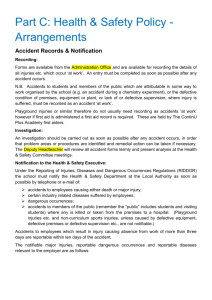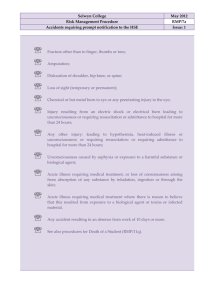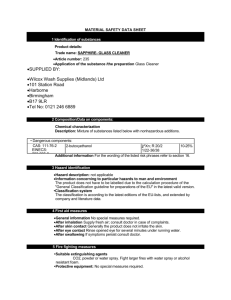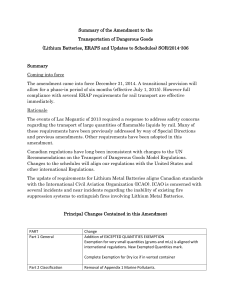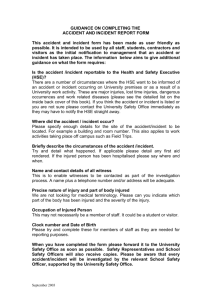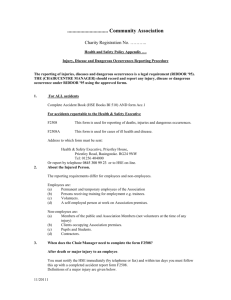Reportable Incidents
advertisement
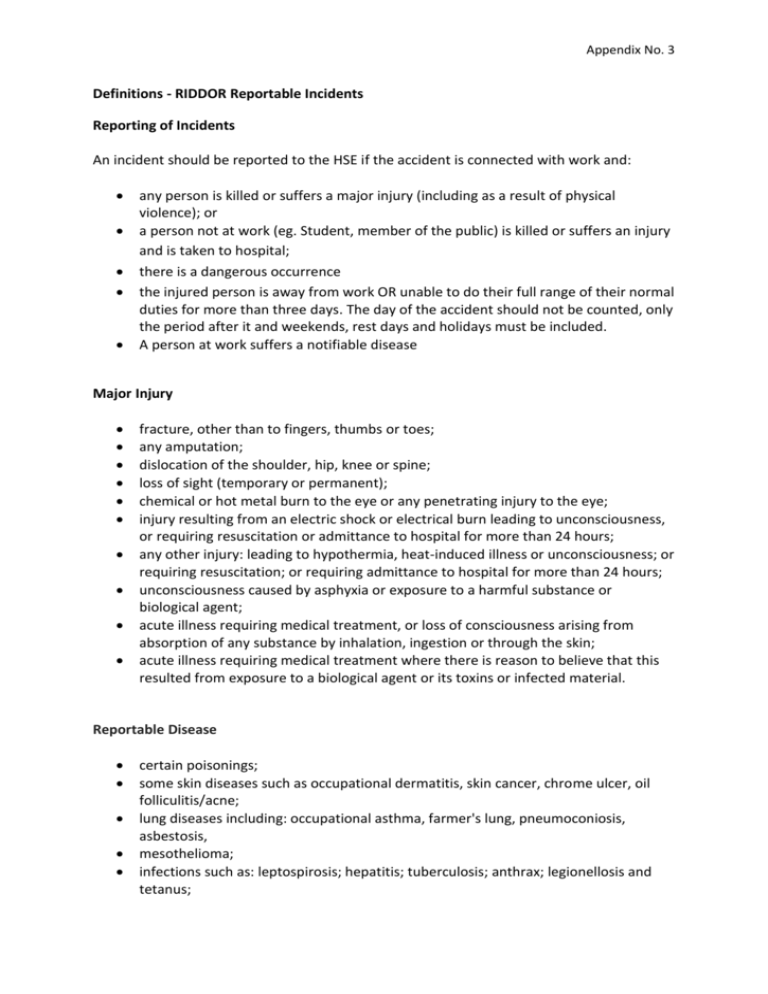
Appendix No. 3 Definitions - RIDDOR Reportable Incidents Reporting of Incidents An incident should be reported to the HSE if the accident is connected with work and: any person is killed or suffers a major injury (including as a result of physical violence); or a person not at work (eg. Student, member of the public) is killed or suffers an injury and is taken to hospital; there is a dangerous occurrence the injured person is away from work OR unable to do their full range of their normal duties for more than three days. The day of the accident should not be counted, only the period after it and weekends, rest days and holidays must be included. A person at work suffers a notifiable disease Major Injury fracture, other than to fingers, thumbs or toes; any amputation; dislocation of the shoulder, hip, knee or spine; loss of sight (temporary or permanent); chemical or hot metal burn to the eye or any penetrating injury to the eye; injury resulting from an electric shock or electrical burn leading to unconsciousness, or requiring resuscitation or admittance to hospital for more than 24 hours; any other injury: leading to hypothermia, heat-induced illness or unconsciousness; or requiring resuscitation; or requiring admittance to hospital for more than 24 hours; unconsciousness caused by asphyxia or exposure to a harmful substance or biological agent; acute illness requiring medical treatment, or loss of consciousness arising from absorption of any substance by inhalation, ingestion or through the skin; acute illness requiring medical treatment where there is reason to believe that this resulted from exposure to a biological agent or its toxins or infected material. Reportable Disease certain poisonings; some skin diseases such as occupational dermatitis, skin cancer, chrome ulcer, oil folliculitis/acne; lung diseases including: occupational asthma, farmer's lung, pneumoconiosis, asbestosis, mesothelioma; infections such as: leptospirosis; hepatitis; tuberculosis; anthrax; legionellosis and tetanus; Appendix No. 3 other conditions such as: occupational cancer; certain musculoskeletal disorders; decompression illness and hand-arm vibration syndrome. Definitions - Dangerous Occurrence collapse, overturning or failure of load-bearing parts of lifts and lifting equipment; explosion, collapse or bursting of any closed vessel or associated pipework; failure of any freight container in any of its load-bearing parts; plant or equipment coming into contact with overhead power lines; electrical short circuit or overload causing fire or explosion; any unintentional explosion, misfire, failure of demolition to cause the intended collapse, projection of material beyond a site boundary, injury caused by an explosion; accidental release of a biological agent likely to cause severe human illness; failure of industrial radiography or irradiation equipment to de-energise or return to its safe position after the intended exposure period; malfunction of breathing apparatus while in use or during testing immediately before use; failure or endangering of diving equipment, the trapping of a diver, an explosion near a diver, or an uncontrolled ascent; collapse or partial collapse of a scaffold over five metres high, or erected near water where there could be a risk of drowning after a fall; unintended collision of a train with any vehicle; dangerous occurrence at a well (other than a water well); dangerous occurrence at a pipeline; failure of any load-bearing fairground equipment, or derailment or unintended collision of cars or trains; a road tanker carrying a dangerous substance overturns, suffers serious damage, catches fire or the substance is released; a dangerous substance being conveyed by road is involved in a fire or released; The following dangerous occurrences are reportable except in relation to offshore workplaces: unintended collapse of: any building or structure under construction, alteration or demolition where over five tonnes of material falls; a wall or floor in a place of work; any false-work; explosion or fire causing suspension of normal work for over 24 hours; sudden, uncontrolled release in a building of: 100 kg or more of flammable liquid; 10 kg of flammable liquid above its boiling point; 10 kg or more of flammable gas; or of 500 kg of these substances if the release is in the open air; accidental release of any substance in a quantity sufficient to cause the death, major injury or any other damage to the health of a person. Appendix No. 3 additional categories of dangerous occurrences apply to mines, quarries, relevant transport systems (railways etc) and offshore workplaces. Note: This list is not exhaustive and the full list of reportable diseases can be obtained by contacting the Health and Safety Adviser on 331 8859.
